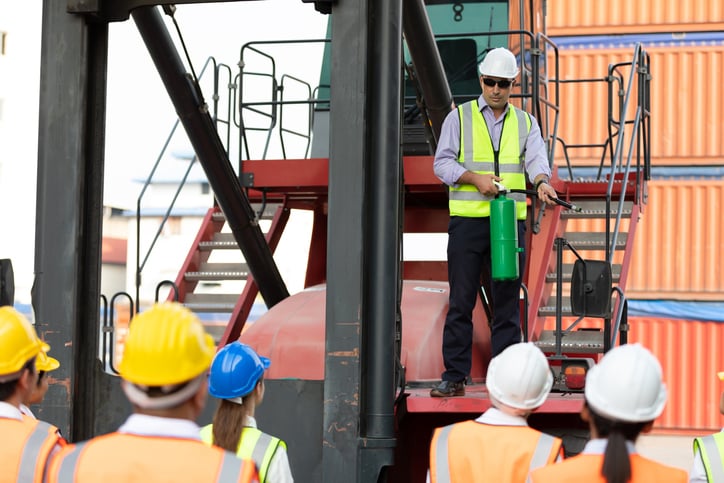
Editorial Note: This article was brought to you courtesy of Rose Morrison, managing editor of Renovated.com.
February is the ideal time to look at continuous growth strategies across construction. Given that it’s CTE Month — otherwise known as Career and Technical Education Month — it would also be a good time to invest some resources in crew management, training and support.
Organized by the Association for Career and Technical Education, CTE Month and the CTE community are about raising awareness for college, higher education and career success. One facet of that program is a push towards continuous learning or ongoing learning that is persistent and highly accessible.
What Is Continuous Growth and Learning?
Don’t fall into the trap of thinking continuous learning is only for college-aged adults or younger. It’s meant for every age and every industry, and would be helpful in every field, especially when it comes to modern technologies.
The world evolves at alarming rates, which means there are always new methods for doing things, new tools, new technologies and beyond. Staying up to date on industry changes is crucial not just for the employees who want to remain relevant in their field, but also for the related businesses. Having an innovative and well-educated team has many competitive advantages. According to Deloitte, firms with continuous learning policies are 46% more likely to be first to market, 92% more likely to innovate and often see 37% higher productivity.
By definition, continuous learning is the pursuit of constant expansion of knowledge and skills. In professional development, one always continues expanding their skill sets by learning new concepts, working with new tools or enhancing their abilities. Think of it as a series of daily habits in the interest of a professional upgrade. The actual term is quite broad, and there’s no single method for deploying a continuous learning process or approach.

When applied to construction, continuous learning would mean professionals branching out — sometimes even beyond their comfort zone — to learn new concepts, skills and technologies. In a labor-constrained ecosystem, continuous learning is vital to business growth. It also ensures the workforce can support itself regardless of the circumstances, as people can step up and take on responsibilities that wouldn’t typically fall into their job description.
For example, you could introduce conventional builders to prefabrication or modular construction. As the industry increasingly moves towards a more sustainable future, prefabricated and modular methods will become more popular and offer many innovative benefits — like reducing the number of deliveries to a job site by up to 90%.
Technology and Construction
Professional development often goes hand-in-hand with technology, merely because the modern industry is constantly growing. Employees tend to pursue these new opportunities to expand their knowledge, be more productive and open up new opportunities.

In construction, even a little understanding of the new platforms and solutions can help on a job site. Some forward-thinking technologies in construction include:
- Virtual Reality (VR): With 3D modeling, BIM and software-based solutions, it’s possible to utilize VR on a job site or off to visualize builds, make engineering and design changes, and even demo designs to clients to increase satisfaction.
- Building Information Modeling (BIM): BIM evolves traditional architecture to make it a more collaborative process. For example, if an architect creates a building design for the core structure, then other parties help contribute to a more realized model, such as graphic designers, engineers and beyond. This also provides an opportunity to see a build and ensure it works before the physical construction begins.
- Off-Site and Prefab Construction: By using technologies like additive manufacturing and 3D printing, it’s possible to engineer and construct builds off-site and assemble them at the correct build location. This form of modern-age construction will require training in the appropriate methods and technologies, such as CAD-based printing tools and design techniques.
- Mobile Applications: While it seems like a broad mention, various software and mobile app solutions can provide intelligent experiences on and off-site, whether that’s by incorporating performance data and analytics or checking in on workers from a remote location.
- Artificial Intelligence (AI) and Machine Learning (ML): Through a combination of AI and ML, construction platforms and hardware can be smarter and more contextually aware. Moreover, ML tools can help discern and understand new project challenges, improve on-site safety, maintain productivity and enable new forms of business — such as preventative maintenance for mission-critical equipment.
- The Internet of Things (IoT): Also referred to as the Industrial Internet of Things in various industries, IoT involves making a bevy of equipment smarter through data-driven sensors. Even something as simple as a forklift can see increased safety with a smart sensor that powers down the system if a potential accident or hazard is detected. That same technology can automate the solutions, improving productivity or enhancing worker experiences. Imagine a smart construction robot that can carry heavy materials, saving manual laborers the effort and potential harm.
Many of these also have new job roles or classifications to go along with the technology, which would benefit those in construction to learn and become familiar with. Understanding the importance of these technologies and how they’re shaping the industry — both now and in the future — is key to building a resourceful and continuous learning environment.
How to Foster a Culture of Continuous Growth and Learning
Here are some tips for fostering a culture of continuous learning within your teams.
- Create the Right Channels
The first step is to deploy or create avenues for employees to upskill and continue their training. That can involve connecting inexperienced workers with more experienced mentors, opening up education and training opportunities, or providing stipends and incentives for pursuing external training, like returning to a trade school or online learning. Of course, that also means informing employees of these opportunities.
Upskilling managers or leaders are always a great place to start, but offering new opportunities to everyone is highly recommended.
- Make It Community-Oriented
Training initiatives are always more engaging when teams work together socially, so it’s an excellent idea to offer community-based learning programs. Learning with others increases engagement and makes the experience more satisfying. In fact, learners who utilize social features watch 30 times more hours of learning content than those who don’t.
It’s not as if gathering socially online is anything new, even in construction. Thanks to social networks and online communities, people understand the value of collaborating with others, remotely or otherwise.
- Keep It Hybrid and Accessible
E-learning — or online learning — is much more flexible than traditional options because workers can become students anywhere. People can learn when and where they want, which is precisely why 83% of people agree a hybrid work model is optimal.
- Focus on New Technology
To keep things relevant and fresh, it makes sense to focus on new technologies, tools and opportunities, many of which employees wouldn’t have seen during earlier training. This can also help train new hires when they come onto a job.
There’s also a point about keeping it relevant. While new technology is always a solid choice, it’s still about training people on devices the team uses, which is practical on the job site.
- Foster Team Mentorships
A valuable asset many successful teams already have at their disposal is long-term and experienced workers. These are people who have been on the job for quite some time but are not necessarily in leadership or management positions. Pairing them up with inexperienced workers — especially newcomers — is a great way to help everyone learn faster.
Most importantly, it gives new hires a point of contact when they run into roadblocks or bumps in the road. Senior leadership doesn’t always have the time or resources to address every concern, but having someone with you in the trenches to help work through any problems can offer better experiences and generate better output from all. Peer-to-peer learning can benefit students and the inexperienced, leading to higher success rates, job confidence and productivity.
- Don’t Forget About Unlearning
Because policies and understanding change over time, conventional training also tends to undergo constant evolution, sometimes reverting or fixing points that are later found to be incorrect. Sometimes, what you know and have used for years is considered safe and familiar to you but may not be so on the job site. Hence, the concept of unlearning — or replacing what you know to be safe with the new and unknown.
Keep It Flowing
Fostering a culture of continuous learning starts with giving employees opportunities to continue their growth through relevant, useful programs. From there, it’s about empowering and supporting them to push through those programs and continue advancing professionally. Luckily, creating hybrid solutions and allowing people to learn and grow on their time is a valid option.
Be sure to focus on new technologies, encourage teams to take advantage of the opportunities they have, and collaborate socially in large groups or in a mentor-mentee-like relationship. Solid training and improved skill sets will benefit the operation greatly, especially when you need versatile support, which means it’s well worth the investment.
This is a guest post written by Rose Morrison, managing editor of Renovated.com